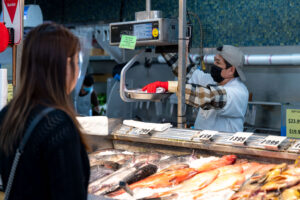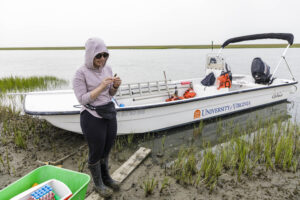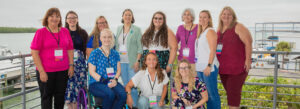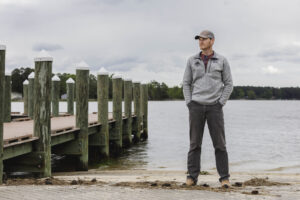Economic Impact:
Collaborative University-Industry Aquaculture Research
You Are Invited
On February 1, 2018, Virginia Sea Grant (VASG) will be hosting a panel discussion at the Virginia Institute of Marine Science (VIMS), William & Mary in Watermen’s Hall, McHugh Auditorium. Congressman Rob Wittman, VASG’s director Troy Hartley, industry partners Mike Congrove of Oyster Seed Holdings and John Vigliotta of Ward Oysters, and VIMS researchers Dick Snyder and Emily Rivest will participate in the panel.
Through the 2017 National Sea Grant competition for collaborative university‐industry aquaculture research projects, Virginia secured more total awards (four leads and two collaborating with other state leads) and more total funds ($1.9M) than any other state in the country – 20 percent of the total available funding nationally. This illustrates that Virginia’s aquaculture industry and university aquaculture science and research are leading the nation. How did we get here?
Collaboration between industry and universities has been critical to the R&D and innovation to get Virginia to the top and will be essential to keeping Virginia there. Sea Grant’s research and extension activities have been catalysts for this collaboration and are embedded in Virginia’s coastal economies. This panel discusses the foundation, current status, and future of the collaborative university-industry partnerships and its economic impacts.
Leading Innovation
Representing VIMS, the headquarters of Virginia Sea Grant (VASG), Congressman Rob Wittman (Virginia District 1) noted, “Virginia is a leading innovator in the emerging industry of aquaculture and I am proud to have VIMS, a major research contributor, in the First Congressional District. Before coming to Congress, I spent 20 years as a shellfish specialist monitoring water quality and environmental health issues in the watershed — so these issues are extremely important to me. Investing in aquaculture is critical to not only seafood production but also to our economy. This work, directly and indirectly, supports the local economy by providing key research that allows industries that rely on the bay to thrive.”
“Coastal communities face unique challenges that only federal-state joint partnerships, such as the Sea Grant Program, can solve,” added Congressman Scott Taylor (Virginia District 2). “I am proud to support this program and look forward to its continued success in promoting the economic and environmental well-being of our coastal communities.” District 2 includes VIMS’ Eastern Shore Laboratory and many leaders and Sea Grant partners from Virginia’s aquaculture industry.
In recent years, shellfish hatcheries of the East and Gulf Coasts have been plagued by limitations to production, the causes of which are unclear. While harmful algal blooms (HABs), and altered seawater carbonate chemistry have received much attention, scientific evidence that either of these contributes significantly to the limitation of hatchery production remains scarce. Emerging evidence has suggested that the production problems have their source in the community of microorganisms that populates the hatcheries. This has prompted broader exploration of the influence of hatchery water clean-up strategies, in addition to carbonate chemistry and HABs, on hatchery environments and oyster and clam larval health.
The four projects detailed below were funded by NOAA’s National Sea Grant Aquaculture Initiative to research these impediments to hatchery production and aquaculture opportunities.
VASG’s director Dr. Troy Hartley says,” Virginia’s national leadership in shellfish aquaculture comes from an innovative industry sector working collaboratively with the world-class research, science and technological capacity of Virginia’s universities. This collaborative research is exactly how we will maintain our national position in the marketplace, and in advancing the state of the knowledge.”
NOAA announced 32 research grants totaling $9.3 million for projects around the country to further develop the nation’s marine and coastal aquaculture industry, and it received 126 proposals requesting nearly $58 million in federal funds.
Sea Grant’s investment in aquaculture research, outreach, and education programs continues to produce results for coastal communities and their economies. Between February 2016 and January 2017, Sea Grant invested $9 million in aquaculture research, technology transfer, and outreach, and reported $90 million in economic impacts, including support of 900 businesses and 1,800 jobs.
Project Descriptions
- Enhancing commercial sustainability in the hatchery production of Eastern oysters and clams: $998,942
- Can carryover effects improve oyster aquaculture production: $149,99
- Identifying strategies to minimize impacts of harmful algal blooms on performance and survival of triploid oysters cultured in lower Chesapeake Bay: $149,902
- Genetic, physiologic, and culture characterization of new Mercenaria mercenaria breeding stocks: $149,650
- Commercializing intensive copepod culture: a transformational foundation essential for increasing domestic production of high-value marine finfish: $221,643
- Overcoming impediments to shellfish aquaculture through legal research and outreach: $210,000
National Comment
Secretary of Commerce Wilbur Ross said, “This country, with its abundant coastline, should not have to import billions of pounds of seafood each year. These grants will promote aquaculture projects that will help us reduce our trade deficit in this key industry.”
The grants were awarded through two competitions to help spur the development and growth of shellfish, finfish, and seaweed aquaculture businesses. The projects include basic and applied research to improve efficient production of seafood, permitting of new businesses, management of environmental health issues, and economic success of aquaculture businesses.
“Public-private partnerships play a vital role in advancing sustainable domestic aquaculture and increasing food security,” said Jonathan Pennock, director of NOAA Sea Grant. “Industry is working alongside researchers on each of these projects, which will help expand businesses, create new jobs and provide economic benefits to coastal communities.”
Media
To download a media release and descriptions for each of the projects listed below, with comments made by researchers and industry partners please click here.
For a full list and short descriptions of the 32 grant projects, visit the NOAA Sea Grant website.
For a selection of possible images that can be used by press outlets, please visit Virginia Sea Grant’s Flickr page.






